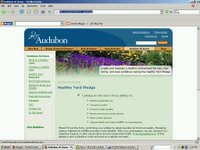A New King Has Taken Over.
14 hours ago
Birding. All the time.
Skin Design:
Free Blogger Skins
 Audubon challenges everyone to begin protecting wild birds (and the environmental health of their yards and families) by taking the Healthy Yard Pledge. Click here to pledge to
Audubon challenges everyone to begin protecting wild birds (and the environmental health of their yards and families) by taking the Healthy Yard Pledge. Click here to pledge to Now the question is...how good is the testing of wild birds in other areas of the world? Are we missing the virus in wild bird populations elsewhere due to faulty testing techniques?
The problem may have been DEFRA's method of collecting samples. Crommie says DEFRA told WWT samplers to moisten a sterile swab on a stick with saline, take a faecal sample from the bird, then put the swab back in its dry plastic tube. The tubes were then kept at refrigerator temperature and taken to the testing laboratories the next day.
Both Nolting and Olsen are adamant that swabs must be immediately immersed in a saline or preservative solution, and also frozen quickly. "If you left a swab in the refrigerator in its sheath like that, it would dry out and you'd lose all your virus," says Olsen. He says whoever planned the tests "should have talked to us". DEFRA has not done large-scale flu surveys before.
"If you just want to identify the viruses present you could put it in a nutrient solution or in ethanol, but you need a transport medium," says Nolting. "We never take dry swabs." Both groups also quickly freeze samples.
An underlying assumption in avian habitat management is that if the manager can provide habitat with appropriate structure at all relevant scales, the target bird species will find and use it. Many of us call this the "Field of Dreams" hypothesis, referring to the movie of that name in which the character played by Kevin Costner hears a voice saying, "if you build it, they will come." Costner's character builds his baseball field and long-dead ballplayers show up, though it takes a while, and not all humans can see the ballplayers, which perhaps has parallels with current Ivory-billed Woodpecker (Campephilus principalis) management.
 I recently finished reading Lyanda Haupt's Pilgrim on the Great Bird Continent. I'm going to be writing a full review for Birder's World magazine, but for now I just wanted to say that this book has really given me a lot to think about. Haupt follows Darwin as he spends five years chasing birds and other creatures around South America and beyond, and shows exactly how these experiences transformed him from an eager young naturalist into a careful observer and serious scientist.
I recently finished reading Lyanda Haupt's Pilgrim on the Great Bird Continent. I'm going to be writing a full review for Birder's World magazine, but for now I just wanted to say that this book has really given me a lot to think about. Haupt follows Darwin as he spends five years chasing birds and other creatures around South America and beyond, and shows exactly how these experiences transformed him from an eager young naturalist into a careful observer and serious scientist.  So, follow Darwin. Watch closely. Think Deeply. As another hero of mine once said, the mysteries of nature "are of deep import; and time, and experience, and careful and ponderous and solemn thoughts can only find them out". Take time to smell the roses, watch the birds, and to ponder the mysteries of the world around you. Join Darwin's posse, and treat yourself to a marvelous ride.
So, follow Darwin. Watch closely. Think Deeply. As another hero of mine once said, the mysteries of nature "are of deep import; and time, and experience, and careful and ponderous and solemn thoughts can only find them out". Take time to smell the roses, watch the birds, and to ponder the mysteries of the world around you. Join Darwin's posse, and treat yourself to a marvelous ride.
The goal of this plan is to describe the essential components of a unified national system for the early detection of HPAI, specifically highly pathogenic H5N1 avian influenza, in migratory birds. While the immediate concern is a potential introduction of highly pathogenic H5N1 avian influenza into the U.S., the development of a system that is capable of detecting the introduction of all HPAI viruses through migratory birds would significantly improve the biosecurity of the Nation. This document provides guidance to Federal, State, university, and non-governmental organizations for conducting HPAI monitoring and surveillance of migratory birds in the U.S. It is expected that this document will be used by agencies and organizations to develop regional and/or state-specific implementation plans for HPAI surveillance.

